Südgeorgien und Süd-Sandwich-Inseln |
|
|
|
| Übersicht – Contents: | |
Südgeorgien und Süd-Sandwich-Inseln |
|
|
|
| Übersicht – Contents: | |
Flaggen – Flags: |
|
 |
seit 1908, Union Flag → quasi Nationalflagge, |
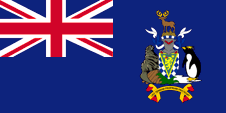 |
seit/since 1999, Flagge der Regierung (Staatsflagge) – flag of the government (state flag), Seitenverhältnis – ratio = 1:2, Quelle/Source, nach/by: Flags of the World  |
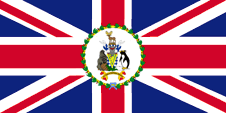 |
seit/since 1999, Flagge des Hohen Kommissars – flag of the Commissioner, Seitenverhältnis – ratio = 1:2, Quelle/Source, nach/by: Flags of the World |
historische Flaggen – historical Flags: |
|
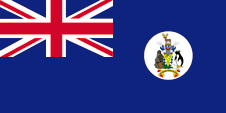 |
1992–1999, Flagge der Regierung (Staatsflagge) – flag of the government (state flag), Seitenverhältnis – ratio = 1:2, Quelle/Source, nach/by: Flags of the World |
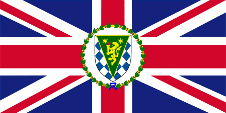 |
1992–1999, Flagge des Hohen Kommissars – flag of the Commissioner, Seitenverhältnis – ratio = 1:2, Quelle/Source, nach/by: Wikipedia (DE) |
sonstige Flaggen – other Flags: |
|
|
verbreitete Varianten, möglicherweise historisch – spread variants, possibly historical: |
|
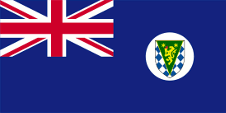 |
1992–1999, Flagge der Regierung (Staatsflagge) – flag of the government (state flag), Seitenverhältnis – ratio = 1:2, Quelle/Source, nach/by: Flags of the World |
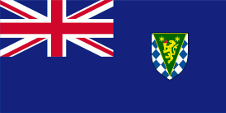 |
1992–1999, Flagge der Regierung (Staatsflagge) – flag of the government (state flag), Seitenverhältnis – ratio = 1:2, Quelle/Source, nach/by: Flags of the World |
| Der Union Jack weißt auf die Verbindungen zu Großbritannien hin. | The Union Jack points to the connexions to United Kingdom. |
Großbritannien hatte in Jahr 1864 ein Flaggensystem eingeführt, in dem:
Seit 1865 durften Schiffe von Kolonialregierungen einen Blue Ensign mit einem Badge (Abzeichen) im fliegenden Ende führen. Die jeweiligen Regierungen sollten entsprechene Bagdes zur Verfügung stellen. Handelsschiffe und seefahrende Privatpersonen aus Kolonien dürfen nur dann einen Red Ensign mit Badge führen, wenn von der britischen Admiralität eine entsprechende Erlaubnis für die Kolonie erteilt wurde. |
United Kingdom introduced a flag system in 1864 in which:
Since 1865 ships of colonial governments were permitted to fly the Blue Ensign with a badge in the flying end of the flag. The respective governments were asked to design appropriate badges. Merchant ships and seafaring persons from colonies were only permitted to use the Red Ensign with a badge, then also named Civil Ensign, if permission has been given to the respective colony by the British admiralty. |
| Ein solches Badge war oft eine auf einer Scheibe platzierte regionale landschaftliche Darstellung, zeigte oft Schiffe, historische Begebenheiten oder konnte auch nur eine Art Logo sein. Sehr oft zeigte ein Badge zusätzlich den Namen des Landes oder auch einen Wahlspruch. Einige Besitzungen hatten aber auch schon von Anfang an ein Wappen, bzw. erhielten über die Jahre eine eigenes Wappen und das Badge wurde abgeschafft. Um ein weitgehend einheitliches Erscheinungsbild im fliegenden Ende der Flaggen zu gewährleisten, wurden Wappen und auch andere Symbole auf einer weißen Scheibe in der Größe der früheren Badges dargestellt. Es gab hier aber auch Ausnahmen, denn einige Kolonien verwendeten diese weiße Scheibe nicht, und platzierten ihr Wappen oder auch nur das Wappenschild - manchmal auch vergrößert - direkt auf das Flaggentuch. Schon in den 40-er Jahre wurde dazu übergegangen die weiße Scheibe zu entfernen und das Wappen direkt zu platzieren oder vergrößert dazustellen. Dieser Umstellungsprozess erfolgte allmählich, nirgendwo gleichzeitig und vollständig. In einigen britischen Besitzungen sind bis heute Flaggen mit der weißen Scheibe in Gebrauch, in anderen nicht mehr und in einigen Gebieten gibt es beide Varianten nebeneinander. | Such a badge was often a regional landscape representation placed on a disk, often showing ships, historical events or even a kind of a logo. Very often, a badge also showed the name of the country or a motto.
Some British possessions, however, already had a coat of arms from the beginning, or their badge was replaced by a coat of arms over the years. To ensure a uniform appearance in the flying end of the flags, coats of arms and other symbols were displayed on a white disk in the size of the earlier badges. There were also exceptions, because some colonies did not use the white disk and placed their escutcheon or even coat of arms directly on the bunting, sometimes enlarged. Already in the '40s they started to remove the white disk and placed the coat of arms directly or enlarged. This conversion process was done gradually, nowhere at the same time and completely. In some British possessions, flags with the white disc are still in use, in others no more and in some areas are both variants in use, next to each other. |
| Auf der Flagge der Behörden (Blue Ensign) erscheint seit 1999 anstelle des 1992 eingeführten Badges das komplette Wappen der Inseln. In der Literatur und im Internet werden vereinzelt Abarten und Varianten dieser Flagge gezeigt. Dabei wird nur das Wappenschild auf der Flagge gezeigt, mal mit und mal ohne weiße Scheibe. Das ist möglicherweise darauf zurückzuführen, dass die Flagge des Hohen Kommissars zwischen 1992 und 1999 tatsächlich nur das Wappenschild zeigte, was man auf die Dienstflagge übertragen hat. |
Since 1999, the complete
coat of arms of the islands has appeared on the flag of the authorities
(Blue Ensign) instead of the badge introduced in 1992. In the literature and on the internet, there are a few variants of this flag. Only the shield is shown on the flag, sometimes with and sometimes without a white disc. This is possibly due to the fact that the flag of the Commissioner between 1992 and 1999 actually only showed the escutcheon, which was transferred to the flag of the authorities. |
| In vielen britischen Besitzungen und teilweise auch im Commonwealth gab und gibt es den Trend, dass der Blue Ensign (Blaue Flagge), also die eigentliche Seeflagge der Behörden mit dem lokalen Badge (Abzeichen), von Behörden auch an Land oder gar von Zivilpersonen verwendet wird. Das gibt es vereinzelt ganz offiziell in dem einseitig Fakten geschaffen wurden. Das wird aber meist nur unter Protest geduldet. Eigentlich repräsentiert der einzelne Bürger die britische Nation, verkörpert im United Kingdom, an Land optisch sichtbar gemacht durch den Union Jack, dann „Union Flag“ genannt, zur See mit der britischen Handelsflagge, dem Red Ensign (Rote Flagge). In einigen wenigen Fällen wurde den Bürgern der Kolonie erlaubt, einen eigenen Red Ensign mit dem Badge der Kolonie auf See zu verwenden, was oft dazu geführt hat, das diese Red Ensigns regelwidrig anstelle der Union Flag auch an Land verwendet werden, auch mit anderen lokalen Badges, etwa in einigen kanadischen Provinzen. Ebenso wurden in manchen britischen Besitzungen von Seiten der Bürger eigenmächtig und ohne Genehmigung Red Ensigns geschaffen und zum Einsatz gebracht. |
In many British possessions and partly also in
the Commonwealth, there has been and
still is a trend for the Blue Ensign, i.e. the actual sea flag of the
authorities with the local badge (insignia), to be used by authorities also
on land or even by civilians. In some cases, this has been done
officially by unilaterally creating facts. However, this is usually only
tolerated under protest. Actually, the individual citizen represents the British nation, embodied in the United Kingdom, visible on land by the Union Jack, then called the "Union Flag", at sea by the British merchant flag, the Red Ensign. In a few cases, the citizens of the colony were allowed to use their own Red Ensign with the badge of the colony at sea, which often led to the use of these Red Ensigns on land instead of the Union Flag, even with other local badges, for example in some Canadian provinces. Similarly, in some British possessions, Red Ensigns were created and used by citizens on their own authority and without permission. |
| Die Flagge des Hohen Kommissars ist ein Standard-Design, älterer Machart, für alle Gouverneure, Leutnant-Gouverneure, Kommissare, Hohen Kommissare und anderer Beamter, die ein entsprechendes Amt ausüben, vorausgesetzt, dass kein neuerer Entwurf verwendet wird. Innerhalb des Kranzes befindet sich immer das Entsprechende Badge oder Wappen. Der Hohe Kommissar von Südgeorgien und den Süd-Sandwich-Inseln ist gleichzeitig der Gouverneur der Falklandinseln. Seine Flagge wird nur verwendet, wenn er die Inseln besucht. | The flag
of the Commissioner is a standard-design of older styling, for all
Governors, Lieutenant-Governors, Commissioners, High-Commissioners and other
administering government officials, provided no newer designs are in use.
Within the wreath the respective badge or coat of arms is always positioned. The Commissioner of South Georgia and the South Sandwich Islands Inseln is at the same time the governor of the Falkland Islands. His flag is only in use if he visits the islands. |
| Quelle/Source: Die Welt der Flaggen, Flags of the World, Wikipedia (EN), Volker Preuß | |
Wappen – Coat of Arms: |
|
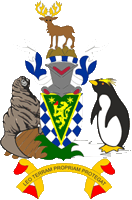 |
seit/since 1992, Wappen von Südgeorgien und den Süd-Sandwich-Inseln – coat of arms of South Georgia and South Sandwich Islands, Quelle/Source, nach/by: Wikipedia (DE) |
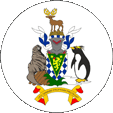 |
1992–1999, Emblem von Südgeorgien und den Süd-Sandwich-Inseln – Badge of South Georgia and South Sandwich Islands, Quelle/Source, nach/by: Wikipedia (DE) |
| Das Wappen des Landes zeigt ein Wappenschild mit einem weiß-blauen schrägen Schachbrettmuster. Darauf ein golden umrandetes grünes Dreieck mit einem goldenen Löwen mit einer Fackel und zwei goldenen Sternen. Das Schild ruht auf einem Untergrund aus Brettern, Gras und Eis. Schildhalter sind ein Seeelephant und ein Pinguin. Oberhalb des Wappenschildes ein Helm mit weiß-blauem Wulst und darauf ein Rentier das auf Felsklippen steht. Ganz unten ein Spruchband mit dem Motto der Inseln. Das Motto lautet: "Leo Terram Propriam Protegat", was soviel heißt wie "Lasst den Löwen sein eigenes Land bewachen". Der goldene Löwe im Wappen ist das Wappentier Großbritanniens, die Fackel weißt auf die wissenschaftliche Forschung auf den Inseln hin und die beiden Sterne stehen für die beiden Inselgruppen, aus denen das Land besteht. Der Pinguin, der Seelephant und das Rentier sind ein Hinweis auf die Fauna des Landes. | The coat
of arms of the country shows a shield with a white-blue diagonal
chessboard-pattern. On it a golden bordered green triangle with a golden
lion with a torch and two golden stars. The shield is based on a undercoat
from planks, grass and ice. Shield-supporters are a sea-elephant and a
penguin. Above the blazon a helmet with a white-blue torus and on it a reindeer which stands on cliffs. Quite below a ribbon with the motto of the islands. The motto is: "Leo Terram Propriam Protegat", what means something like "Let the Lion protect its own Land". The golden lion in the
coat of arms is the heraldic symbol of United Kingdom, the torch points out
for the scientific research on the islands and the both stars stand for the
both archipelagos the country consists of. |
| Quelle/Source: Wikipedia (D), Wikipedia (EN), Volker Preuß | |
| Landkarte – Map: |
Lage: |
Landkarte des Landes: |
|
Forschungsstationen und ehemalige Siedlungen |
|
|
| Zahlen und Fakten – Numbers and Facts: | |
|
|
|
|
|
|
|
|
|
|
|
|
|
|
|
|
|
|
| Quelle/Source: GSGSSI, Wikipedia (D) | |
| 1675 ·
der englische Seefahrer Anthony de la Roche entdeckt die Insel Südgeorgien,
die zunächst als Roche-Insel bekannt wird, deren Lage jedoch in
Vergessenheit geriet 1775 · der englische Seefahrer James Cook entdeckt Südgeorgien erneut und entdeckt die Süd-Sandwich-Inseln und beansprucht sie für Großbritannien 1819 · der russische Seefahrer Fabian Gottlieb von Bellingshausen entdeckt weitere Inseln des Süd-Sandwich-Archipels 1819 · die Süd-Shetland-Inseln (2 300 m², unbewohnt) werden von Großbritannien in Besitz genommen 1821 · die Süd-Orkney-Inseln (662 km², unbewohnt) werden von Großbritannien in Besitz genommen 1882 · Errichtung der Deutschen Forschungsstation Moltke (Moltke Harbour) in der Royal Bay im Südosten der Insel 1904 · Gründung der Walfängersiedlung Grytviken durch Carl Anton Larsen 1908 · Großbritannien nimmt Südgeorgien und die Süd-Sandwich-Inseln als Dependenzen der Falklandinseln offiziell in Besitz, die Süd-Shetland-Inseln und die Süd-Orkney-Inseln werden weitere Dependenzen der Falklandinseln 1908 · Gründung der Walfängersiedlung Godthul 1909 · Gründung der Walfängersiedlungen Leith Harbour und Ocean Harbour 1909 · Gründung von King Edward Point als Verwaltungszentrum in der Nähe von Grytviken 1910 · Gründung der Walfängersiedlung Husvik 1912 · Gründung der Walfängersiedlung Stromness 1916 · Gründung der Walfängersiedlung Prince Olav Harbour 1916 · der Polarforscher Ernest Henry Shackleton besucht Grytviken 1920 · die Walfängersiedlung Ocean Harbour wird aufgegeben und verlassen 1922 · der Polarforscher Ernest Henry Shackleton stirbt in Grytviken und wird dort auch begraben 1927 · Argentinen erhebt Anspruch auf Südgeorgien 1929 · die Walfängersiedlung Godthul wird aufgegeben und verlassen 1931 · die Walfängersiedlung Stromness wird aufgegeben und verlassen 1934 · die Walfängersiedlung Prince Olav Harbour wird aufgegeben und verlassen 1938 · Argentinen erhebt Anspruch auf die Süd-Sandwich-Inseln 1949 · King Edward Point wird als wissenschaftliche Forschungsstation ausgebaut 1955–1956 · Argentinen besetzt die Thule-Insel, die südlichste der Süd-Sandwich-Inseln und betreibt über einen Sommer den Militärstützpunkt Teniente Esquivel 1958 · Großbritannien errichtet die Forschungsstation Bird Island im Norden von Südgeorgien 1960 · die Walfängersiedlung Husvik wird aufgegeben und verlassen 1960–1961 · die Siedlung Stromness wird als Reparaturwerft betrieben 1962 · die Süd-Shetland-Inseln und die Süd-Orkney-Inseln werden administrativ von den Falklandinseln abgetrennt und dem Britischen-Antarktis-Territorium angeschlossen 1965 · die Walfängersiedlung Leith Harbour wird aufgegeben und verlassen 1965 · der Ort Grytviken wird als Walfängersiedlung aufgegeben 1976 · Argentinen besetzt erneut die Thule-Insel, und errichtet den Militärstützpunkt Corbeta Uruguay 19.03.1982 · Besetzung der verlassenen Walfängerstation Leith Harbour durch Argentinische Truppen 03.04.1982 · Besetzung von Grytviken durch Argentinische Truppen 25.04.1982 · Rückeroberung von Südgeorgien durch Britische Truppen im Rahmen des Falkland-Krieges, Stationierung einer britischen Garnison in King Edward Point 20.06.1982 · Argentinen räumt den Militärstützpunkt Corbeta Uruguay 03.10.1985 · Südgeorgien und die Süd-Sandwich-Inseln werden administrativ von den Falklandinseln abgetrennt und bilden eine eigene Verwaltungseinheit 1993 · Ausdehnung der 12-Meilen Fischereizone auf 200 Meilen rund um die Inseln 1995 · Argentinien sagt der Gewalt zur Durchsetzung seiner Interessen in Südgeorgien ab 21.03.2001 · die britische Garnison wird von King Edward Point abgezogen |
| 1675 ·
the English seafarer Anthony de la Roche discovers the island of South
Georgia, which first of all became noted as Roche Island but its position
however fell in oblivion 1775 · the English seafarer James Cook discoveres South Georgia again and discoveres the South Sandwich Islands and claims them for United Kingdom 1819 · the Russian seafarer Fabian Gottlieb von Bellingshausen discoveres further islands of the South Sandwich Archipelago 1819 · the South Shetland Islands (888 sq.mi., uninhabited) become appropriated by United Kingdom 1821 · the South Orkney Islands (256 sq.mi., uninhabited) become appropriated by United Kingdom 1882 · construction of the German research station Moltke (Moltke Harbour) in the Royal Bay in the southeast of the island 1904 · foundation of the whaler housing estate Grytviken by Carl Anton Larsen 1908 · United Kingdom officially appropriates South Georgia and the South Sandwich Islands as dependenceies of the Falkland Islands, the South Shetland Islands and the South Orkney Islands become further dependenceies of the Falkland Islands 1908 · foundation of the whaler housing estate Godthul 1909 · foundation of the whaler housing estates Leith Harbour and Ocean Harbour 1909 · foundation of King Edward Point as administrative center near Grytviken 1910 · foundation of the whaler housing estate Husvik 1912 · foundation of the whaler housing estate Stromness 1916 · foundation of the whaler housing estate Prince Olav Harbour 1916 · the polar researcher Ernest Henry Shackleton visits Grytviken 1920 · the whaler housing estate Ocean Harbour becomes given up and abandoned 1922 · the polar researcher Ernest Henry Shackleton dies in Grytviken and was buried there 1927 · Argentina claims South Georgia 1929 · the whaler housing estate Godthul becomes given up and abandoned 1931 · the whaler housing estate Stromness becomes given up and abandoned 1934 · the whaler housing estate Prince Olav Harbour becomes given up and abandoned 1938 · Argentina claims the South Sandwich Islands 1949 · King Edward Point becomes extended as scientific research station 1955–1956 · Argentina occupies Thule Island, the most southern island of the South Sandwich Islands and operates over one summer the military base Teniente Esquivel 1958 · United Kingdom builds the research station of Bird Island in the north of South Georgia 1960 · the whaler housing estate Husvik becomes given up and abandoned 1960–1961 · the smallholding of Stromness becomes operated as repairing shipyard 1962 · the South Shetland Islands and the die South Orkney Islands become administratively separated from the Falkland Islands and affiliated to the British Antarctic Territory 1965 · the whaler housing estate Leith Harbour becomes given up and abandoned 1965 · the place Grytviken becomes given up as whaler station 1976 · Argentina occupies again Thule Island and establishes the military base Corbeta Uruguay 19th of March 1982 · occupation of the abandoned whaler station Leith Harbour by Argentinian troops 3rd of April 1982 · occupation of Grytviken by Argentinian troops 25th of April 1982 · re-conquest of South Georgia by British troops on the occasion the Falkland War, station of a British garrison in King Edward Point 20th of June 1982 · Argentina quits the military base Corbeta Uruguay 3rd of October 1985 · South Georgia and the South Sandwich Islands become administratively separated from the Falkland Islands and represent from now on an own administration unit 1993 · extension of the 12 mile fishery zone to 200 miles around the islands 1995 · Argentina cancels the power for the achievement of its interests in South Georgia 21st of March 2001 · the British garrison withdraws from King Edward Point |
| Quelle/Source: 1) Wikipedia (EN), 2) Wikipedia (EN), Wikipedia (DE) |
| Als Südgeorgien 1675 entdeckt wurde, trug es zunächst den Namen seines Entdeckers. Es hieß "Roche-Insel". Als James Cook die Insel 1775 wiederentdeckte nannte er sie zu Ehren des Britischen Königs Georg III. "Isle of Georgia". | When South Georgia was discovered in 1675 it was initially called after the name of its discoverer. The name was "Roche Island". As James Cook re-discovered the island in 1775 he named it to honour the British King George III. "Isle of Georgia". |
| James Cook entdeckte im Jahre 1775 auch die meisten der 1 200 km von Südgeorgien entfernten, unbewohnten Süd-Sandwich-Inseln. Er nannte sie zu Ehren des Vierten Earl of Sandwich, dem Ersten Lord der Admiralität "Sandwich-Inseln". Später wurde noch das Wort "Süd" hinzugefügt, um sie von Hawaii zu unterscheiden, das damals auch den Namen Sandwich-Inseln trug. | James Cook also discovered in the year 1775 the most of the 750 miles from South Georgia distant and uninhabited South Sandwich Islands. He named them to honour the 4th Earl of Sandwich, the First Lord of the Admirality "Sandwich Islands". Later was added the word "South" to distinguish them from Hawaii, which at that time was called Sandwich Islands too. |
| Quelle/Source: Wikipedia (DE) | |